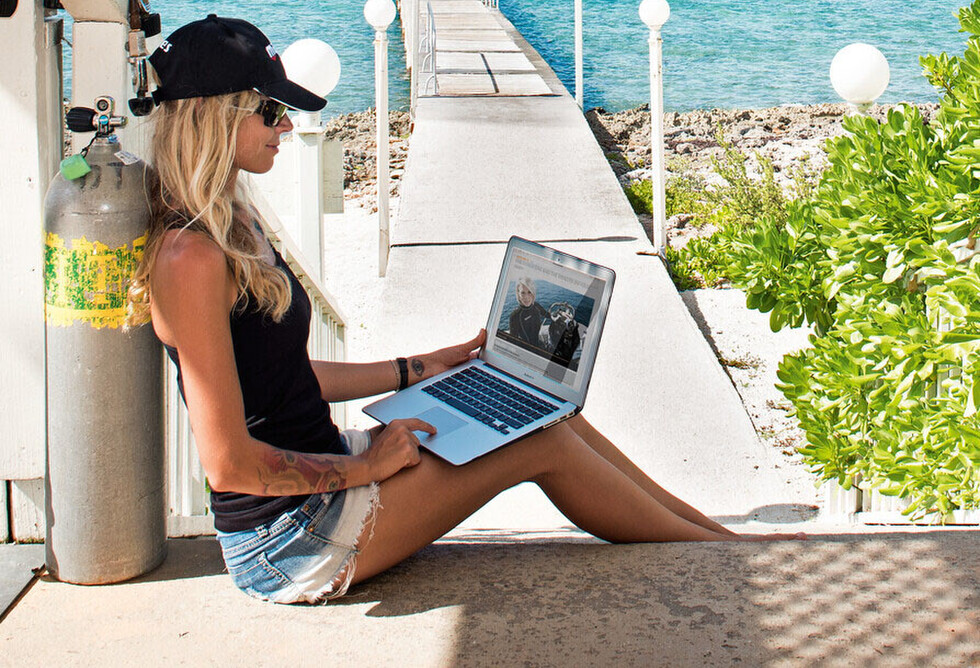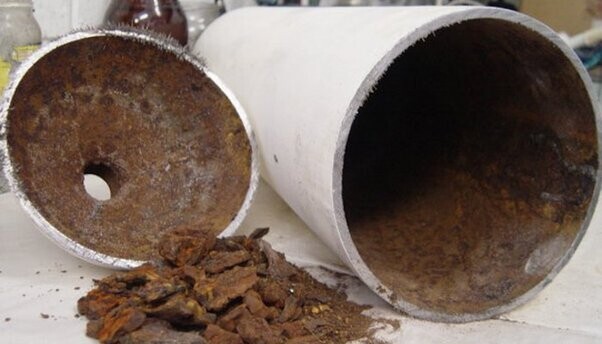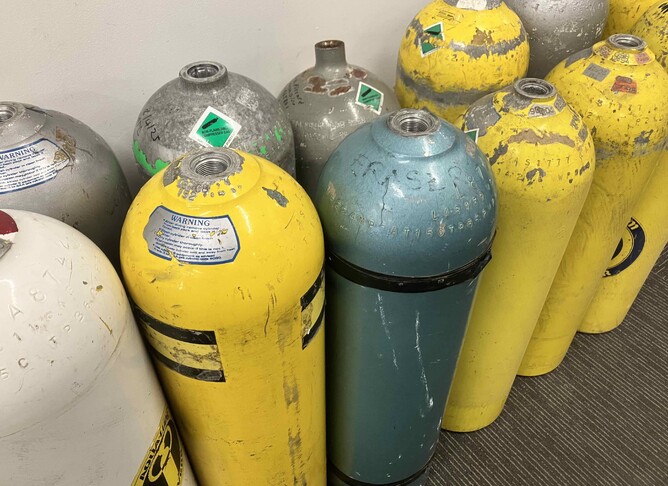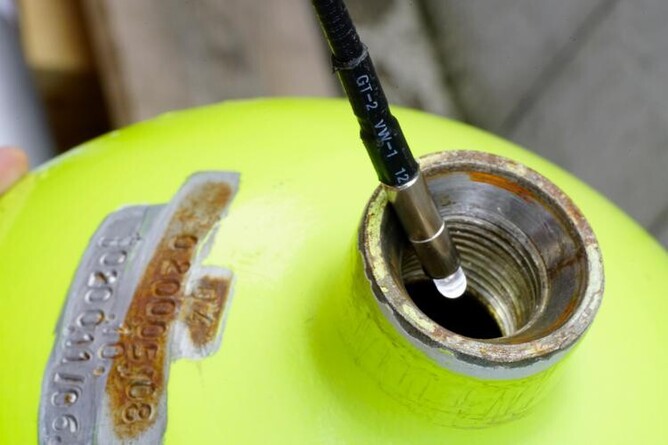Have you got a problem with rust?
An essential piece of SCUBA equipment is of course the SCUBA cylinder, we simply can't live without them (underwater). These large, heavy and expensive items come in two varieties of should I say materials, being aluminium and steel.
Generally speaking the aluminium variety is well suited to hot, tropical and humid locations whereas the steel variety is more than at home in colder, temperate waters.
Within Aotearoa (New Zealand) both exist and are well utilised however the steel cylinder is really a better choice for our waters.
The reason for this choice is simply because the cylinder becomes a part of our buoyancy system. Generally we dive thicker wetsuits (5mm - 7mm), with many divers using drysuits during the cooler winter months. This dress configuration requires a much greater mass of lead in order to be able to descend, therefor a steel cylinder requires less lead on the hip.
The one negative issue of the steel cylinder over an aluminium cylinder is its susceptibility to rusting if not correctly looked after. In this blog we will look at why they rust both inside and out and what you can do to prevent this phenomena. Grab yourself a cuppa and read on.....
What Causes Rust on the outside of Scuba Cylinders?
The enemy of every steel cylinder? Moisture and salt—a corrosive duo that accelerates rust formation.
The Science of Rust
Rust (iron oxide) forms when iron reacts with oxygen in the presence of water or moisture. Saltwater doesn’t cause rust, but it speeds up the process by making it easier for electrons to move. Here’s how it happens:
1. The Reaction Begins: Iron loses electrons to oxygen, creating ferrous and ferric ions.
2. Water Steps In: These ions react with water, forming iron hydroxides.
3. The Domino Effect: The hydroxides dehydrate, creating more iron compounds. Eventually, the rust flakes off, exposing fresh metal to continue the cycle.
Saltwater vs. Freshwater: Why the Ocean Wins (at Corrosion)
Saltwater is a superstar at conducting electricity, thanks to its high concentration of dissolved ions. This means:
- Electrons flow more freely, accelerating rust.
- Even salt spray or humid air can trigger corrosion—no full submersion needed! (Ever seen a boat engine after a season at sea? Exactly.)
The Bottom Line for Divers
We can’t avoid saltwater, but we can outsmart rust with proper cylinder care. In the next section, we’ll cover proven maintenance tips to keep your tank in top shape.
SCUBA Cylinder Corrosion Maintenance Guide
Daily Maintenance Routine
1. Post-Dive Rinsing
Remove the plastic boot and rinse clean
Always rinse the cylinder with fresh water immediately after saltwater diving
Spend 2-3 minutes thoroughly rinsing to dissolve all salt deposits
Pay special attention to:Valve areas
Accessory attachment points
Any exposed metal or paint chips
Dry completely with a microfiber towel, especially around fittings and also dry the plastic boot prior to reinstalling.
2. Handling & Storage Best Practices
Use padded racks or cylinder boots to prevent paint damage
Secure cylinders in BCs to prevent movement and rubbing
Avoid placing cylinders on abrasive surfaces especially concrete that may hold moisture
Store cylinders with a positive pressure (minimum 30 bar)
For long term storage, drain cylinder to around 30 bar, this will reduce metal fatigue
Scuba cylinders should always be stored upright and secured to prevent falling over. If moisture and corrosion are present in the cylinder, storing the cylinder on its side will cause the corrosion to attack the thinner wall (the base is thicker)
Monthly Deep Maintenance
For frequently used cylinders (filled weekly or more):
Remove all accessories and valves
Perform complete interior/exterior wash and dry
Note: only conduct the above if trained to do so, otherwise get a professional to conduct this for you.
Inspect for:
New paint chips or scratches
Early rust formation
Valve thread condition
Reassemble with clean, dry components
Biannual Critical Maintenance
Every 12 months:
1. Full Disassembly
Remove valve completely
Inspect interior with bright light
Check for moisture or contamination
Have the cylinder valve professionally serviced
Note: This should be conducted only by a trained professional
Long-Term Storage Protocol
For cylinders unused >30 days:
1. Preparation
Empty to 20-30 bar residual pressure
Complete interior/exterior cleaning
Remove all accessories
2. Storage Conditions
Store upright in climate-controlled environment
Ideal conditions:
<50% humidity
Stable temperature (15-25°C/59-77°F)
No saltwater exposure
3. Reactivation Checklist
Full visual inspection
Verify O-ring condition
Pressure test if stored >12 months
Note: This should be conducted only by a trained professional
Pro Tip: Keep a maintenance log with dates for all servicing and inspections to track cylinder condition over time.
What causes rust inside of cylinders?
1. Moisture
Moisture is the leading cause of internal rust in scuba cylinders. When a cylinder is filled with compressed air, any residual humidity inside can lead to corrosion—especially if the cylinder valve wasn’t properly dried before filling. Poor drying practices can trap moisture, creating ideal conditions for rust to develop.
2. Environmental Exposure
Scuba cylinders often face harsh conditions, including saltwater and high humidity. Saltwater is highly corrosive, and even thorough rinsing after a dive may leave behind lingering moisture, accelerating rust formation.
3. Infrequent Use
Cylinders left unused for long periods are at higher risk. Stagnant air inside can promote moisture buildup, particularly if the tank wasn’t fully dried or sealed properly after its last fill.
4. Degraded Internal Coatings
Some cylinders have protective internal coatings to prevent corrosion, but these can wear down over time. Once the coating is compromised, bare metal is exposed, making the tank vulnerable to rust. Regular inspections help detect coating damage early.
5. Running your SCUBA cylinder low or empty whilst under the water.
This outdated practice is a sure fire way to get rust inside your cylinder, just don't do it. Also leave a reserve in your cylinder (40 bar minimum)
The Dangers of Rust in SCUBA Cylinders
1. Safety Risks
Rust weakens the tank’s structural integrity, increasing the risk of leaks or even catastrophic failure under pressure—a serious hazard for divers.
2. Contaminated Air Supply
Rust particles can mix with the breathing air, posing respiratory health risks and reducing air quality. Rust particles in your cylinder may also travel into both your 1st and 2nd stages causing issues and possible malfunction.
3. Higher Maintenance Costs
Neglecting rust or having poor diving protocols can lead to expensive repairs or even tank replacement. Preventive care and utilising correct diving practices is by far the more cost-effective and safer option than dealing with severe corrosion damage.
How to Prevent Internal Rust
1. Regular Inspections
Schedule professional visual inspections at least once a year to catch rust or coating damage early.
2. Use Dry, High-Quality Air Sources
Only fill cylinders at reputable dive shops with proper air filtration systems. Avoid uncertified fill stations (like garage compressors), as they may not remove moisture effectively. In New Zealand, WorkSafe regulations require professional training for cylinder filling—stick to certified providers.
3. Keep cylinders in Use
Frequent use prevents moisture buildup. If you’re not diving often, lower the cylinder pressure to around 30 bar and store it properly.
4. Annual Internal Cleaning
Professional cleaning removes moisture, hydrocarbons, and other contaminants, helping to prolong the tank’s lifespan.
5. Proper Storage
Store cylinders in a cool, dry place, away from humidity and extreme temperature swings.
Conclusion
Rust in scuba cylinders is a preventable but serious issue. By understanding its causes and following best practices—regular inspections, proper filling, and correct storage—divers can ensure their safety and extend their dive equipments lifespan.
Stay proactive with maintenance, and enjoy safer, worry-free diving!
If you would like to learn more about equipment maintenance and repair why not sign up for our SSI equipment techniques program?
For more information CLICK HERE.
If you would like to get professionally trained in SCUBA cylinder filling procedures (NZUA)
Aotearoa Dive utilises the modern compressor filling procedures - all conducted by trained professionals. We do not use unreliable self filled (repack-able) filters but employ a "Securus" filtration system, this ensures the optimum gas purity for breathing gas. We test our gas every three months and display the gas purity check for customers to peruse.
Find out more about our filtration system by CLICKING HERE.
Aotearoa Dive - doing it right since 2021



